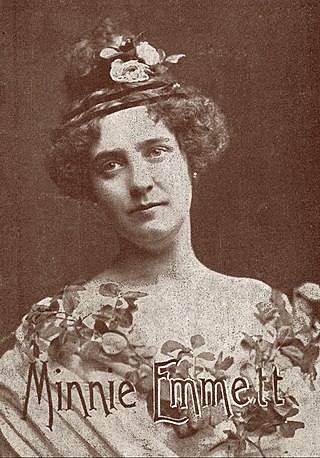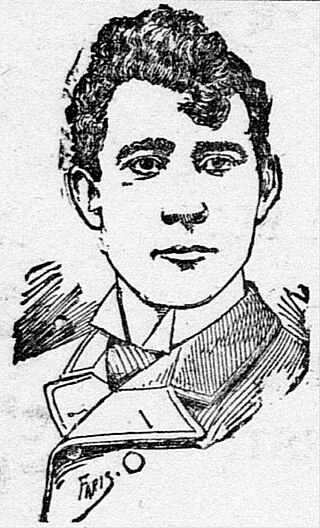
Arthur Francis Collins was an American baritone who was one of the pioneer recording artists, regarded in his day as "King of the Ragtime Singers".

George J. Gaskin was one of the most popular singers in the United States during the 1890s and an early American recording artist.

Leonard Garfield Spencer was an American singer, composer, booking agent and vaudeville star who was considered one of the most popular recording artists in the United States from the 1890s to the 1910s.

Daniel William Quinn was an American tenor. He was one of the first American singers to become popular in the new medium of recorded music. Quinn was a very successful recording artist whose career spanned from 1892 to 1918. Quinn recorded many of his hits in the legendary Tin Pan Alley of New York City.

Stephen Carl Porter was an American pioneer recording artist, who recorded prolifically for numerous recording companies in the 1890s and early 1900s. He was also an entrepreneur who helped establish the recording industry in India in the early years of the twentieth century, and successfully marketed a new form of hearing aid.

Bohumir Kryl was a Czech-American financial executive and art collector who is most famous as a cornetist, bandleader, and pioneer recording artist, for both his solo work and as a leader of popular and Bohemian bands. He was one of the major creative figures in the era of American music known as the "Golden Age of the Bands".

John W. Myers, who was usually credited as J. W. Myers, was an American baritone singer, who recorded widely in the United States between the early 1890s and early 1917. His recordings, including "Two Little Girls in Blue" (1893), "The Sidewalks of New York" (1895), "Just Tell Them That You Saw Me" (1895), "When You Were Sweet Sixteen" (1901), "On a Sunday Afternoon" (1902), "Way Down In Old Indiana" (1902), and "In the Good Old Summer Time" (1902), were among the most popular of the period.

Albert Charles Campbell was an American popular music singer who recorded between the late 1890s and the 1920s. He was best known for his many duo recordings with Henry Burr, and as a member of the Peerless Quartet and other vocal groups, but also recorded successfully as a solo singer both under his own name and under various pseudonyms including Frank Howard.
Robert Leonhardt was an Austrian operatic baritone who sang several notable roles with the New York Metropolitan Opera between 1913 and 1922. He made numerous recordings for major record labels, both in Europe and in the United States.

Charles D'Almaine was an American violinist with the New York Metropolitan Opera, a chiropractor, and a pioneer recording artist.

Josie Sadler (1871–1927) was for twenty years a leading American stage comedienne known for her "Dutch" (German) dialect routines and heavy-set appearance. She made several early phonograph recordings for the major companies of the time, and also made several silent films, mostly for Vitagraph. She retired from show business to operate her deceased husband's electrical research business.

Issler's Orchestra was an early recording ensemble, and perhaps the first popular band. The group formed in the fall of 1889 at the Edison Laboratory Because the purpose of the group was only to make recordings, it had only four or five performers, a form that would come to be known as a "parlor orchestra". Personnel and instrumentation varied in the first year, but most sessions included Edward Issler on piano, George Schweinfest on flute and D.B. Dana on cornet. Clarinetist William Tuson and xylophonist Charles P. Lowe would also become core members in time.

Joe Belmont was the stage name of Joseph Walter Fulton who was a whistling performer and baritone in the United States who came to be known as "The Human Bird". He was one of the most popular recording artists in the years leading to 1900 and sang as a baritone and whistled for the Columbia Quartet along with Albert Campbell, Jim Reynard and Joe Majors. His top-selling records included "Beautiful Birds, Sing On", "Tell Me, Pretty Maiden".

Minnie Emmett was a singer and pioneer recording artist active in New York in the 1890s and 1900s.

Estella Louise Mann was an American singer, recording artist, and record executive active in New York in the 1890s. She was one of the first women to make a living as a recording artist, and the first woman to run a record company.

Joseph Tunnicliffe Pope, Jr., known professionally as Murray K. Hill was an American vaudeville comic and recording artist active from the 1900s-1920s.

George W. Graham was an American monologist, patent medicine salesman, and pioneer recording artist.

Frank P. Banta was an American pianist and recording artist active in the 1890s and 1900s.
The Discography of American Historical Recordings (DAHR) is a database catalog of master recordings made by American record companies during the 78rpm era. The 78rpm era was the time period in which any flat disc records were being played at a speed of 78 revolutions per minute. The DAHR provides some of these original recordings, free of charge, via audio streaming, along with access to the production catalogs of those same companies. DAHR is part of the American Discography Project (ADP), and is funded and operated in partnership by the University of California, Santa Barbara, the National Endowment for the Humanities, and the Packard Humanities Institute.
George Wilton Ballard was an American tenor and pioneer recording artist who was prolific between 1912 and 1926.

















